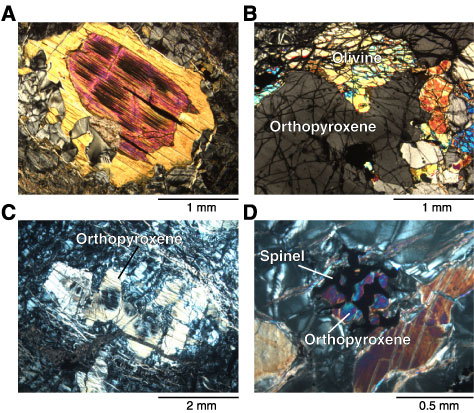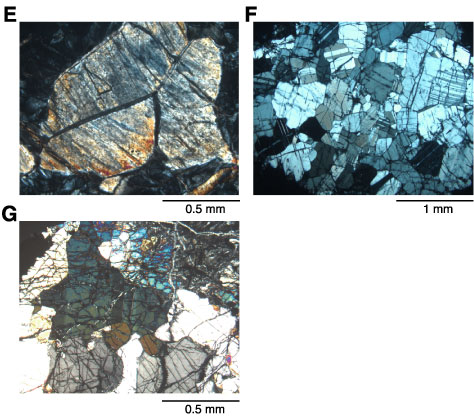
Figure F44. Photomicrographs showing protogranular and protointergranular textures. A. Protogranular serpentine bastite after orthopyroxene (Sample 209-1268A-13R-2, 3–6 cm) (cross-polarized light [XPL]: blue filter; field of view [FOV] = 2.75 mm; image 1268A_016). B. Protogranular texture showing interlocking orthopyroxene and olivine (Sample 209-1268A-3R-3, 6–9 cm) (XPL: blue + light gray filters; FOV = 2.75 mm; image 16268A_014). C. Protointergranular serpentine bastite after orthopyroxene showing the ragged, embayed, commonly intergranular appearance of orthopyroxene pseudomorphs that are characteristic of this texture (Sample 209-1268A-2R-2, 70–73 cm) (XPL: blue filter; FOV = 5.5 mm; image 1268A_046). D. Spinel clot intergrown with small serpentine bastite after orthopyroxene in a protointergranular harzburgite (Sample 209-1268A-19R-1, 51–53 cm) (XPL: blue filter; FOV = 1.4 mm; image 1268A_048).
E. Strain-free serpentine bastites replacing large orthopyroxene neoblasts with a well-developed polygonal texture following high-temperature deformation of a primary orthopyroxene grain (Sample 209-1268A-17R-3, 66–68 cm)
(XPL: blue filter; FOV = 1.4 mm; image 1268A_047). F. Recrystallized plagioclase in an otherwise little deformed gabbro showing polygonal texture. Locally there are slightly bent plagioclase grains with deformation twins (Sample 209-1268A-21R-1, 37–39 cm)
(XPL: blue + gray filters; FOV = 5.5 mm; image 1268A_050). G. Olivine with kink bands showing protogranular texture. Note equigranular nature and large grain size in this textural type (Sample 209-1268A-4R-1, 124–127 cm)
(XPL: blue filter; FOV = 1.4 cm; image 1268A_029).





![]()